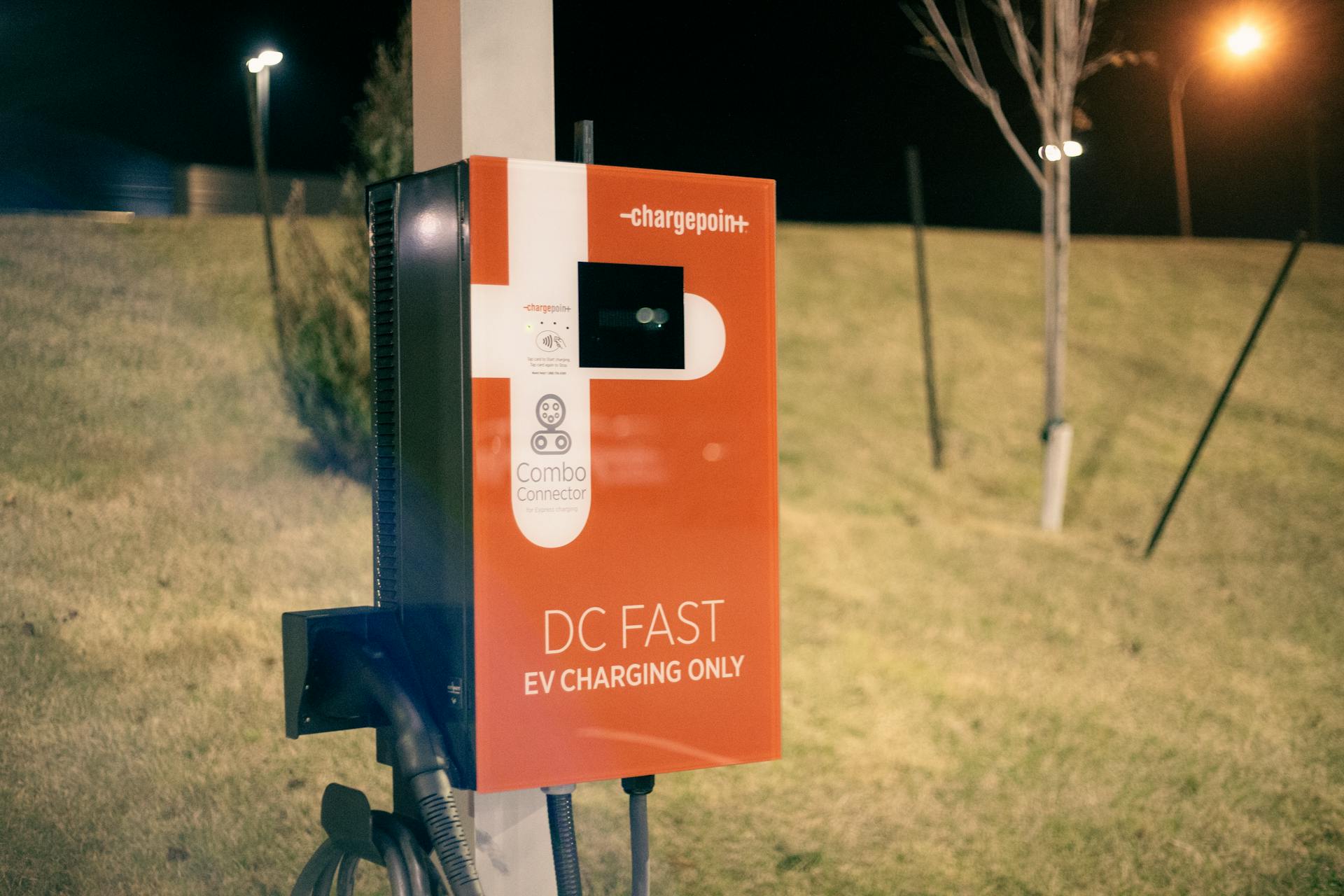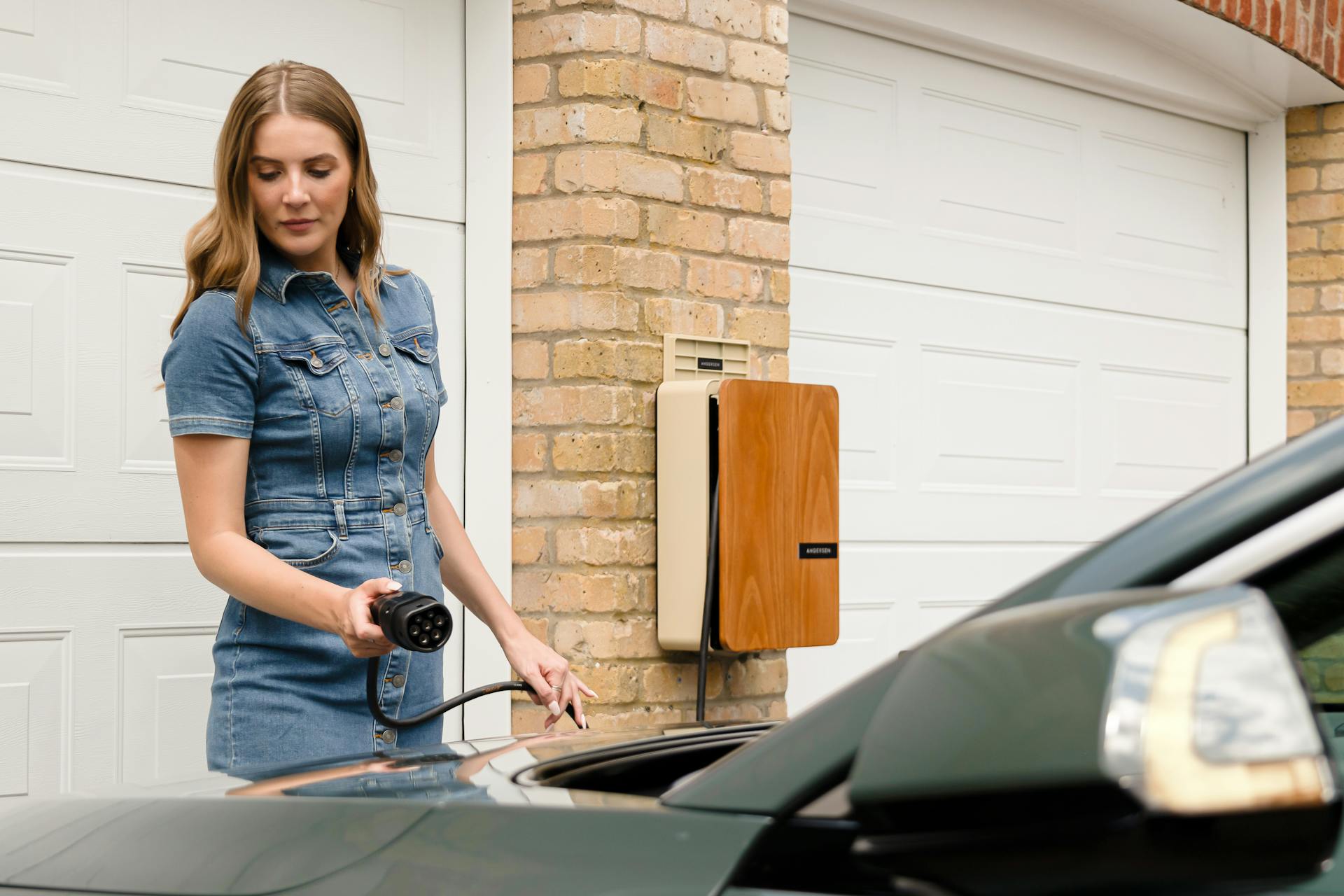
EV/Ebitda is a popular valuation metric used to assess a company's financial health. It's calculated by dividing a company's enterprise value by its earnings before interest, taxes, depreciation, and amortization (Ebitda).
The higher the EV/Ebitda ratio, the more expensive the company is relative to its earnings. This means that investors are willing to pay a premium for the company's growth prospects.
A lower EV/Ebitda ratio, on the other hand, indicates that the company is undervalued. However, a very low ratio can also be a sign of financial distress.
A unique perspective: The Current Ratio Measures a Company's
What Is EV/Ebitda?
EV/Ebitda is a financial metric that helps investors evaluate a company's valuation.
It's calculated by dividing a company's Enterprise Value (EV) by its Earnings Before Interest, Taxes, Depreciation, and Amortization (Ebitda).
A lower EV/Ebitda ratio often indicates that a company's stock is undervalued, making it a potentially good investment opportunity.
What Is EBITDA?
EBITDA is a financial metric that stands for Earnings Before Interest Taxes Depreciation and Amortization. It's often used in valuation as a proxy for cash flow.
Not all industries find EBITDA to be a useful metric, and it's not a perfect proxy for cash flow.
Big Picture Metric

The EV/EBITDA metric offers a big-picture look at a company's worth. It's a key tool for investors to assess a company's future potential and growth prospects.
By eliminating interest, taxes, depreciation, and amortization, the EV/EBITDA metric considers more financial factors than the P/E metric. This gives you a broader view of a company's financial situation.
The EV/EBITDA metric is particularly useful for looking at a company's future potential, rather than just its current earnings and share prices. It's a way to gauge a company's long-term prospects and potential for growth.
Using both the EV/EBITDA and P/E metrics can give you a more complete picture of a company's financial situation. They offer different insights into a company's success and growth potential.
Explore further: Upside Potential Ratio
Advantages and Disadvantages
Using EV/EBITDA to evaluate a company has its advantages. It provides a more comprehensive picture of a company's financial health than traditional metrics.
The advantage of using EV/EBITDA is that it takes into account a company's debt and cash, making it a more accurate representation of its value. This is especially useful when evaluating companies with significant debt or cash holdings.
One of the key advantages of EV/EBITDA is that it allows for easier comparison between companies of different sizes and industries.
Additional reading: What Are Asset Management Companies
Advantages and Disadvantages

Using EV/EBITDA has its benefits, and one of the main advantages is that it helps evaluate a company's value. It does this by considering both the company's equity and its debt, providing a more comprehensive picture.
The sections below will explain the advantages of using EV/EBITDA to evaluate a company.
One of the key advantages is that EV/EBITDA is a useful metric for comparing companies with different capital structures. This is because it takes into account the total enterprise value, which includes both equity and debt.
While useful, EV/EBITDA does come with a few downsides to keep in mind.
Another advantage of EV/EBITDA is that it can be used to identify undervalued companies. By comparing a company's EV/EBITDA ratio to its industry average, investors can spot potential bargains.
EV/EBITDA is a useful metric for evaluating companies with high levels of debt. This is because it considers the total enterprise value, which includes the company's debt obligations.
You might like: What Is a Good Long Term Debt to Equity Ratio
Disadvantages of P/E
P/E has its share of downsides. It doesn't look at a company's debt, so you might get a misleading picture of its financial situation. Many investors ask which is better, using the EV/EBITDA vs. P/E multiple comparisons. The best advice is to use both metrics, as they offer different insights into a company's success and growth potential. Together, EV/EBITDA and P/E multiple can paint a clearer picture of a company's present and future.
If this caught your attention, see: The Present Value of Multiple Cash Flows Is
Calculating EV/Ebitda
Calculating EV/EBITDA can be a complex task, but it's a crucial step in assessing a company's valuation. If you're confident in the accuracy of all the numbers in the formula, it's a brilliant metric to use for company valuation.
To calculate the Enterprise Value (EV), you'll need to add a company's market capitalization, total debt, minority interest, and preferred shares, then subtract cash and cash equivalents. This is a straightforward calculation, but it's essential to get it right.

The formula for Enterprise Value is: Enterprise Value = Market Capitalization + Total Debt + Minority Interest + Preferred Shares - Cash and Cash Equivalents. Once you have the Enterprise Value, you can calculate the EBITDA (Earnings Before Interest, Taxes, Depreciation, and Amortization) by adding back the amounts for interest, taxes, depreciation, and amortization to the net income.
To calculate the EV/EBITDA ratio, simply divide the Enterprise Value by the EBITDA. This will give you the Enterprise Multiple, which can be used to compare the company's valuation to industry peers.
Here's a step-by-step guide to calculating EV/EBITDA:
1. Gather 3 years of historical financial information for the company, including revenue, gross profit, EBITDA, and EPS.
2. Gather current market data, including share price, number of shares outstanding, and net debt.
3. Calculate the current EV for the company by adding market capitalization and net debt.
4. Divide the EV by the EBITDA for each of the historical years of financial data.
5. Compare the EV/EBITDA multiples for each year to identify trends and patterns.
6. Determine why the company has a premium or discounted EV/EBITDA ratio compared to its peers.
7. Make a conclusion about what EV/EBITDA multiple is appropriate for the company you're trying to value.
By following these steps, you can accurately calculate the EV/EBITDA ratio and make informed decisions about a company's valuation.
If this caught your attention, see: Enterprise Value-ebitda Multiple
Comparing Companies
Comparing companies using the EV/EBITDA ratio allows for a relative assessment of their valuation levels. This helps identify outliers, potential investment opportunities, or areas of overvaluation.
Companies with higher EV/EBITDA multiples may indicate higher growth expectations, stronger market positions, or unique competitive advantages.
To conduct a thorough comparative analysis, you should research each comparable company to ensure they're suitable for comparison. Eliminate companies that differ significantly from the target in size, product offering, market reach, or other critical factors.
The EV/EBITDA ratio provides a standardized measure considering a company's market value and operational performance. This makes it easier to evaluate and compare companies with varying sizes, capital structures, or levels of profitability.
By comparing the EV/EBITDA multiples across selected companies, you can gain insights into relative valuations and identify potential outliers or discrepancies. This can be done by analyzing the variations in multiples in a comparable company analysis, also known as a Comps table.
The EV/EBITDA ratio is particularly effective when valuing stable and mature businesses, as it comprehensively assesses a company's operating performance by considering its earnings and debt structure.
Here's an interesting read: Real Estate Asset Management Companies
Limitations

The EV/EBITDA ratio has its limitations, and it's essential to be aware of them to make informed investment decisions. One limitation is that it can misrepresent a company's liquidity and cash flow, making it look more profitable than it is.
In some cases, the EV/EBITDA ratio can be misleading because it removes non-core financial aspects, such as interest, taxes, depreciation, and amortization, which can give a more positive picture of a company's financial health.
A company's debt can be a double-edged sword. On one hand, high debt can indicate poor potential, but on the other hand, it can also indicate a company's ability to generate liquid cash and flexibility, increasing its growth potential.
Investors should be cautious of value traps, where low EV/EBITDA multiples create an illusion of a value investment, but the fundamentals of the industry or company point toward negative returns. This can happen when investors assume that a stock's past performance is indicative of future returns.
Curious to learn more? Check out: The Dhandho Investor the Low-risk Value Method to High Returns

Here are some key things to watch out for when using the EV/EBITDA ratio:
- Value traps: stocks with low multiples due to fundamental issues with the company or its industry
- Forward multiples: should be lower than the TTM multiples
- Catalysts: understanding the company and industry catalysts is crucial
To avoid value traps, it's essential to know the company and industry fundamentals, including expected profitability and the catalysts for the company and industry.
A unique perspective: Ev Ebitda Multiple by Industry
Financial Performance Review
Companies of all sizes and industries strive for financial success and long-term growth. Enterprises continuously evaluate their operations and financial metrics to remain competitive and achieve their objectives.
The EV/EBITDA ratio is widely recognized and commonly used in the financial community. It is a well-established metric frequently referenced and discussed in economic research, investment reports, and industry analyses.
This ratio offers a look at a company from the inside, which can be far more reliable than the value according to the market perspective, which can be highly subjective. By eliminating interest, taxes, and other non-core financial aspects, investors and accountants can more accurately assess how well a company is doing.

Understanding the EV/EBITDA ratio can help business leaders make informed decisions and optimize their operations to drive profitability. It is essential to be aware of its limitations and use it with other financial metrics when making investment decisions.
The EV/EBITDA ratio is a valuable tool for assessing a company's valuation and comparing it to its peers within the same industry.
Valuation Methods
The EV/EBITDA ratio is a powerful valuation method that offers a big-picture look at a company's worth. It eliminates interest, taxes, depreciation, and amortization, allowing for a more comprehensive assessment of a company's operating performance.
In a Discounted Cash Flow (DCF) model, the EV/EBITDA ratio is used to estimate the terminal value component, which represents the value of a company's expected cash flows beyond the explicit forecast period. This approach enables a more holistic assessment of the company's long-term value.
To calculate EV/EBITDA, you can follow eight steps, which include estimating the enterprise value, determining the EBITDA, and applying the EV/EBITDA multiple. This comprehensive valuation analysis gives you a valuable perspective on the target company's worth and its positioning within the industry.

The EV/EBITDA ratio is particularly effective when valuing stable and mature businesses, as it comprehensively assesses a company's operating performance by considering its earnings and debt structure.
Here are some common valuation multiples, including EV/EBITDA, EV/EBIT, and EV/Unlevered Free Cash Flow. These multiples are used to value businesses and compare their worth, but it's essential to understand the connection between the numerator and denominator.
Enterprise value multiples are better than equity value multiples because they allow for direct comparison of different firms, regardless of capital structure. Equity value multiples, on the other hand, are influenced by leverage and accounting differences.
By using both EV/EBITDA and P/E multiple comparisons, you can gain a clearer picture of a company's present and future. They offer different insights into a company's success and growth potential, making them a valuable tool for informed investment decisions.
Here's an interesting read: What Is Good Debt Equity Ratio
Frequently Asked Questions
What is a good EV EBITDA ratio?
A good EV/EBITDA ratio is generally considered to be below 10, but industry averages vary widely and sector-specific comparisons are more relevant. This ratio can indicate a more attractive valuation, but it's not a hard-and-fast rule.
What is the difference between EV EBITDA and EBITDA?
EV/EBITDA is a valuation metric that combines a company's enterprise value (EV) with its earnings before interest, taxes, depreciation, and amortization (EBITDA). EBITDA, on the other hand, is a profitability metric that measures a company's earnings before non-operating items
Is a higher or lower EV EBITDA better?
A lower EV/EBITDA ratio is generally considered more attractive for investors, indicating a potentially undervalued company. A lower ratio suggests the company's value is relatively low compared to its earnings.
What is the EV EBITDA multiple method?
The EV/EBITDA multiple method is calculated by dividing a company's enterprise value by its EBITDA, helping investors gauge its value compared to peers. This ratio is the inverse of EBITDA/Enterprise Value, providing a different perspective on a company's valuation.
What is the EV EBITDA multiple for Coca Cola?
The current EV-to-EBITDA multiple for Coca-Cola is 19.39. This is within the company's historical range of 14.89 to 26.47.
Sources
- https://www.klipfolio.com/resources/kpi-examples/financial/ev-ebitda-vs-pe-multiple
- https://www.klipfolio.com/resources/kpi-examples/financial/enterprise-value-to-ebitda
- https://macabacus.com/valuation/multiples
- https://www.investopedia.com/terms/e/ev-ebitda.asp
- https://corporatefinanceinstitute.com/resources/valuation/ev-ebitda/
Featured Images: pexels.com


